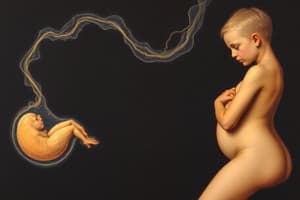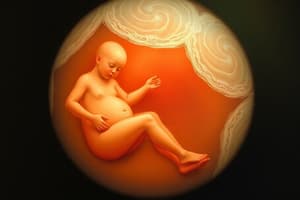Podcast
Questions and Answers
What is the primary function of the placenta?
What is the primary function of the placenta?
- Facilitating the exchange of nutrients and waste between mother and fetus (correct)
- Protection of the fetus from external pathogens
- Production of hormones
- Providing oxygen to the fetus
Which of these factors can contribute to developmental issues in a fetus?
Which of these factors can contribute to developmental issues in a fetus?
- Maternal nutrition
- Exposure to environmental toxins
- Maternal stress levels
- All of the above (correct)
What is the primary role of the umbilical cord?
What is the primary role of the umbilical cord?
- Providing blood supply to the fetus
- Connecting the fetus to the placenta
- Transporting nutrients to the fetus
- All of the above (correct)
Which of the following statements is TRUE about fetal movement?
Which of the following statements is TRUE about fetal movement?
What is the stage of labor where the cervix fully dilates and the fetus is pushed through the birth canal?
What is the stage of labor where the cervix fully dilates and the fetus is pushed through the birth canal?
During which stage of prenatal development does the formation of the neural plate occur?
During which stage of prenatal development does the formation of the neural plate occur?
Which of the following fetal developments occurs during weeks 9-12?
Which of the following fetal developments occurs during weeks 9-12?
Which of the following best describes the process by which the blastocyst becomes embedded in the uterine wall?
Which of the following best describes the process by which the blastocyst becomes embedded in the uterine wall?
At what stage of prenatal development are the majority of major organs fully formed?
At what stage of prenatal development are the majority of major organs fully formed?
What is the primary function of the neural plate?
What is the primary function of the neural plate?
Which of the following is NOT a factor that influences fetal development?
Which of the following is NOT a factor that influences fetal development?
During which weeks of prenatal development is the fetus considered viable, meaning capable of surviving outside the womb?
During which weeks of prenatal development is the fetus considered viable, meaning capable of surviving outside the womb?
What is the primary difference between the embryonic and fetal periods of development?
What is the primary difference between the embryonic and fetal periods of development?
Flashcards
Environmental Factors
Environmental Factors
Exposure to toxins and hazards affecting fetal development.
Genetic Predisposition
Genetic Predisposition
Genetic factors influencing conditions like Down syndrome in fetal development.
Placenta
Placenta
Organ that exchanges nutrients and waste between mother and fetus.
Fetal Movement
Fetal Movement
Signup and view all the flashcards
Birth Process
Birth Process
Signup and view all the flashcards
Fertilization
Fertilization
Signup and view all the flashcards
Zygote Development
Zygote Development
Signup and view all the flashcards
Implantation
Implantation
Signup and view all the flashcards
Germinal Period
Germinal Period
Signup and view all the flashcards
Embryonic Period
Embryonic Period
Signup and view all the flashcards
Fetal Period
Fetal Period
Signup and view all the flashcards
Factors Influencing Development
Factors Influencing Development
Signup and view all the flashcards
Neural Plate Formation
Neural Plate Formation
Signup and view all the flashcards
Study Notes
Fertilization and Initial Development
- Fertilization typically occurs in the fallopian tube, where the sperm penetrates the ovum's outer membrane.
- Fusion of the male and female pronuclei initiates the zygote's development.
- The zygote undergoes rapid cell divisions (cleavage) forming a morula and then a blastocyst.
- The blastocyst implants into the uterine wall, marking the beginning of pregnancy.
- Implantation involves the blastocyst embedding in the uterine lining.
Stages of Prenatal Development
- Germinal period (weeks 1-2): Conception to implantation; rapid cell division.
- Embryonic period (weeks 3-8): Major organ systems begin to develop. Key structures form including the heart, brain, and limbs.
- Fetal period (weeks 9-40): Continued development of all organs and systems. The fetus grows significantly in size and becomes increasingly responsive to external stimuli.
Embryonic Development (Weeks 3-8)
- Week 3: Formation of the neural plate, which will develop into the brain and spinal cord. Primitive heart tube begins to beat.
- Week 4: Limb buds emerge, and the major body structures continue to develop.
- Week 5: Facial features start to form. The heart begins to pump blood.
- Week 6-8: Digestive system and respiratory system further develop. All major organs have their foundational structures. Rapid growth continues.
Fetal Development (Weeks 9-40)
- Weeks 9-12: The fetus is now recognizable as a human and continues to grow and develop. Bone development is apparent. Fingernails and toenails start to form. Sex is visible by ultrasound.
- 13-28 weeks: Active growth and development occur. Fine details on the face, such as ears and nostrils, become fully developed. The lungs begin to mature. The central nervous system develops rapidly. Increased movement occurs.
- Weeks 29-40: Lungs complete maturation. Body fat increases. Brain growth continues extensively. The fetus gains weight and matures. Sensory development continues. The fetus is typically viable (capable of survival outside the womb) in the latter part of this period.
Factors Influencing Development
- Nutrition: Essential for all aspects of fetal development, particularly for brain and organ development.
- Maternal Health: Physical and emotional well-being, including the absence of infections or diseases, significantly influence healthy development.
- Environmental Factors: Exposure to toxins, medications, and other environmental hazards can negatively impact fetal development.
- Genetic Predisposition: Genetic factors play a critical role. Conditions like Down syndrome or other genetic abnormalities may affect development.
Placenta and Fetal Circulation
- The placenta facilitates the exchange of nutrients and waste products between the mother and fetus.
- The umbilical cord connects the fetus to the placenta.
- Fetal circulation is a unique circulatory system with adaptations for efficient transfer of oxygen and nutrients.
Fetal Movement and Reflexes
- Fetal movement begins in the early stages of pregnancy and increases in intensity and complexity as the fetus matures.
- Fetal reflexes develop, demonstrating responsiveness to stimuli.
Birth Process
- Labor: Contractions to dilate the cervix and push the fetus out.
- Delivery: Movement of the fetus through the birth canal.
- Afterbirth: Expulsion of the placenta.
Studying That Suits You
Use AI to generate personalized quizzes and flashcards to suit your learning preferences.




